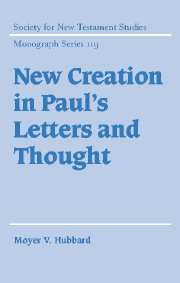Book contents
- Frontmatter
- Contents
- Acknowledgments
- List of abbreviations
- 1 Introduction: the current debate
- PART I NEW CREATION: CENTRAL JEWISH TEXTS
- Part II FROM DEATH TO LIFE: NEW CREATION IN THE CONTOURS OF PAUL'S THOUGHT
- 5 From death to life: insights from cultural anthropology
- 6 Newness of life: Romans 6.1–11
- 7 Newness of the Spirit: Romans 7.1–6
- 8 Spirit, newness, life: the Pauline antecedents
- 9 Crucified with Christ: Galatians 2.19–20
- Part III THE OLD AND THE NEW: NEW CREATION IN THE CONTEXT OF PAUL'S LETTERS
- References
- Index of passages cited
- Index of modern authors
6 - Newness of life: Romans 6.1–11
Published online by Cambridge University Press: 02 December 2009
- Frontmatter
- Contents
- Acknowledgments
- List of abbreviations
- 1 Introduction: the current debate
- PART I NEW CREATION: CENTRAL JEWISH TEXTS
- Part II FROM DEATH TO LIFE: NEW CREATION IN THE CONTOURS OF PAUL'S THOUGHT
- 5 From death to life: insights from cultural anthropology
- 6 Newness of life: Romans 6.1–11
- 7 Newness of the Spirit: Romans 7.1–6
- 8 Spirit, newness, life: the Pauline antecedents
- 9 Crucified with Christ: Galatians 2.19–20
- Part III THE OLD AND THE NEW: NEW CREATION IN THE CONTEXT OF PAUL'S LETTERS
- References
- Index of passages cited
- Index of modern authors
Summary
Reales Sterben ist notwendig … für die neue Existenz nach Paulus.
Herbert Braun, “Das ‘Stirb und Werde’”The transition from puberty rites of primitive societies to Paul's death–life symbolism is neither as abrupt nor as novel as might first appear. In fact, the connection has been noticed before, though previous discussions have focused exclusively on Romans 6 and the relationship between Paul's view of baptism and that of Hellenistic mystery religions. The general synthesis of initiatory symbolism offered in chapter 5, while written independently of A. J. M. Wedderburn's treatment, dovetails nicely with his survey of “life through death” in Greco-Roman mystery religions. One of his conclusions with respect to Romans 6 is particularly noteworthy:
Thus it is true that “life through death” is attested in the mysteryrites and that this would provide an analogy to Paul's teaching on baptism and one which would lie close to hand … But its presence in the mysteries would be only one analogy among several and, moreover, it could be argued that the idea lay near to hand in any rite of passage, and was therefore a natural image to use in the context of an explication of the Christian initiatory rite.
James Dunn, assessing the affinities between Lucius' initiation into the Isis cult and Romans 6.3–4, reaches a similar conclusion:
- Type
- Chapter
- Information
- New Creation in Paul's Letters and Thought , pp. 91 - 103Publisher: Cambridge University PressPrint publication year: 2002



